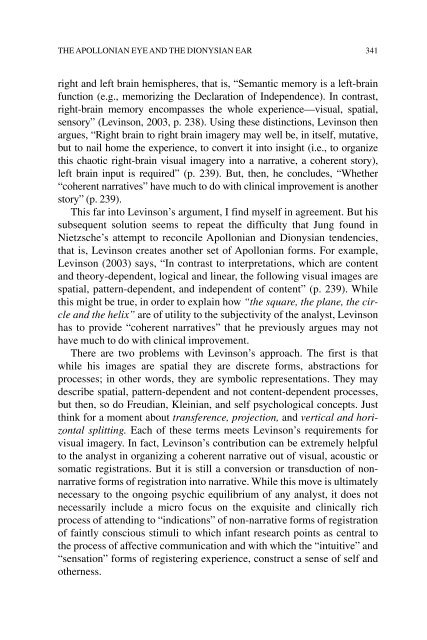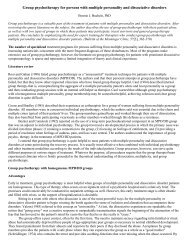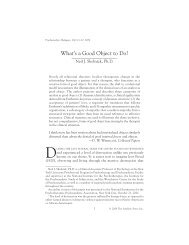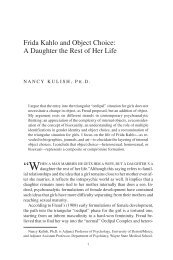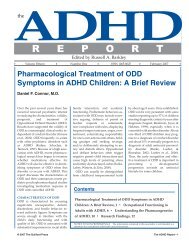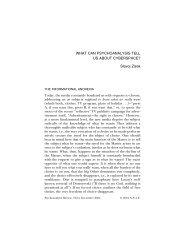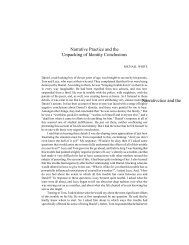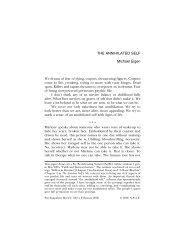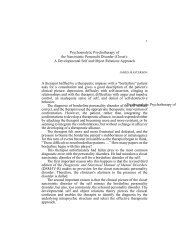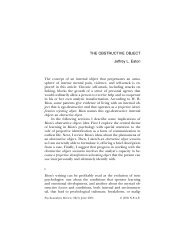The Apollonian Eye and the Dionysian Ear - PsyBC
The Apollonian Eye and the Dionysian Ear - PsyBC
The Apollonian Eye and the Dionysian Ear - PsyBC
Create successful ePaper yourself
Turn your PDF publications into a flip-book with our unique Google optimized e-Paper software.
THE APOLLONIAN EYE AND THE DIONYSIAN EAR 341<br />
right <strong>and</strong> left brain hemispheres, that is, “Semantic memory is a left-brain<br />
function (e.g., memorizing <strong>the</strong> Declaration of Independence). In contrast,<br />
right-brain memory encompasses <strong>the</strong> whole experience—visual, spatial,<br />
sensory” (Levinson, 2003, p. 238). Using <strong>the</strong>se distinctions, Levinson <strong>the</strong>n<br />
argues, “Right brain to right brain imagery may well be, in itself, mutative,<br />
but to nail home <strong>the</strong> experience, to convert it into insight (i.e., to organize<br />
this chaotic right-brain visual imagery into a narrative, a coherent story),<br />
left brain input is required” (p. 239). But, <strong>the</strong>n, he concludes, “Whe<strong>the</strong>r<br />
“coherent narratives” have much to do with clinical improvement is ano<strong>the</strong>r<br />
story” (p. 239).<br />
This far into Levinson’s argument, I find myself in agreement. But his<br />
subsequent solution seems to repeat <strong>the</strong> difficulty that Jung found in<br />
Nietzsche’s attempt to reconcile <strong>Apollonian</strong> <strong>and</strong> <strong>Dionysian</strong> tendencies,<br />
that is, Levinson creates ano<strong>the</strong>r set of <strong>Apollonian</strong> forms. For example,<br />
Levinson (2003) says, “In contrast to interpretations, which are content<br />
<strong>and</strong> <strong>the</strong>ory-dependent, logical <strong>and</strong> linear, <strong>the</strong> following visual images are<br />
spatial, pattern-dependent, <strong>and</strong> independent of content” (p. 239). While<br />
this might be true, in order to explain how “<strong>the</strong> square, <strong>the</strong> plane, <strong>the</strong> circle<br />
<strong>and</strong> <strong>the</strong> helix” are of utility to <strong>the</strong> subjectivity of <strong>the</strong> analyst, Levinson<br />
has to provide “coherent narratives” that he previously argues may not<br />
have much to do with clinical improvement.<br />
<strong>The</strong>re are two problems with Levinson’s approach. <strong>The</strong> first is that<br />
while his images are spatial <strong>the</strong>y are discrete forms, abstractions for<br />
processes; in o<strong>the</strong>r words, <strong>the</strong>y are symbolic representations. <strong>The</strong>y may<br />
describe spatial, pattern-dependent <strong>and</strong> not content-dependent processes,<br />
but <strong>the</strong>n, so do Freudian, Kleinian, <strong>and</strong> self psychological concepts. Just<br />
think for a moment about transference, projection, <strong>and</strong> vertical <strong>and</strong> horizontal<br />
splitting. Each of <strong>the</strong>se terms meets Levinson’s requirements for<br />
visual imagery. In fact, Levinson’s contribution can be extremely helpful<br />
to <strong>the</strong> analyst in organizing a coherent narrative out of visual, acoustic or<br />
somatic registrations. But it is still a conversion or transduction of nonnarrative<br />
forms of registration into narrative. While this move is ultimately<br />
necessary to <strong>the</strong> ongoing psychic equilibrium of any analyst, it does not<br />
necessarily include a micro focus on <strong>the</strong> exquisite <strong>and</strong> clinically rich<br />
process of attending to “indications” of non-narrative forms of registration<br />
of faintly conscious stimuli to which infant research points as central to<br />
<strong>the</strong> process of affective communication <strong>and</strong> with which <strong>the</strong> “intuitive” <strong>and</strong><br />
“sensation” forms of registering experience, construct a sense of self <strong>and</strong><br />
o<strong>the</strong>rness.


